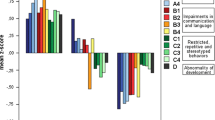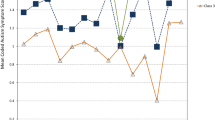Abstract
Existing models of autism spectrum disorder (ASD) disagree as to whether the core features should be conceptualized as convergent (related) or divergent (unrelated), and the few previous studies addressing this question have found conflicting results. We examined standardized parent ratings of symptoms from three domains (social, communication, repetitive behaviors) in large samples of typically developing children, children with ASD, and ASD subgroups. Our results suggest that the most evidence for divergence lies in typically developing children and lower severity ASD cases, while more evidence for convergence is found in a subset of cases with more severe impairment on any core feature. These results highlight the importance of subgrouping ASD given the degree of phenotypic heterogeneity present across the autism spectrum.


Similar content being viewed by others
References
Austin, E. J. (2005). Personality correlates of the broader autism phenotype as assessed by the Autism Spectrum Quotient (AQ). Personality and Individual Differences, 38(2), 451–460.
Barrett, P. T., & Kline, P. (1981). The observation to variable ratio in factor analysis. Personality Study and Group Behavior, 1(1), 23–33.
Benjamini, Y., & Hochberg, Y. (1995). Controlling the false discovery rate: A practical and powerful approach to multiple testing. Journal of the Royal Statistical Society B, 57, 289–300.
Berument, S. K., Rutter, M., Lord, C., Pickles, A., & Bailey, A. (1999). Autism screening questionnaire: Diagnostic validity. The British Journal of Psychiatry, 175(5), 444–451.
Bishop, S. L., Hus, V., Duncan, A., Huerta, M., Gotham, K., Pickles, A., … Lord, C. (2013). Subcategories of restricted and repetitive behaviors in children with autism spectrum disorders. Journal of Autism and Developmental Disorders, 43(6), 1287–1297.
Comrey, A. L., & Lee, H. B. (1992). Interpretation and application of factor analytic results. In A. L. Comrey & H. B. Lee (Eds.), A first course in factor analysis. Hlilsdale: Lawrence Erlbaum Associate.
Constantino, J. N., & Gruber, C. P. (2002). The social responsiveness scale. Los Angeles: Western Psychological Services.
Constantino, J. N., Przybeck, T., Friesen, D., & Todd, R. D. (2000). Reciprocal social behavior in children with and without pervasive developmental disorders. Journal of Developmental & Behavioral Pediatrics, 21(1), 2–11.
Cuccaro, M. L., Shao, Y., Grubber, J., Slifer, M., Wolpert, C. M., Donnelly, S. L., … Pericak-Vance, M. A. (2003). Factor analysis of restricted and repetitive behaviors in autism using the autism diagnostic interview-R. Child Psychiatry and Human Development, 34(1), 3–17.
Frazier, T. W., Ratliff, K. R., Gruber, C., Zhang, Y., Law, P. A., & Constantino, J. N. (2014). Confirmatory factor analytic structure and measurement invariance of quantitative autistic traits measured by the Social Responsiveness Scale-2. Autism, 18(1), 31–44.
Georgiades, S., Szatmari, P., Zwaigenbaum, L., Duku, E., Bryson, S., Roberts, W., … Mahoney, W. (2007). Structure of the autism symptom phenotype: A proposed multidimensional model. Journal of the American Academy of Child & Adolescent Psychiatry, 46(2), 188–196.
Gotham, K., Risi, S., Pickles, A., & Lord, C. (2007). The autism diagnostic observation schedule: Revised algorithms for improved diagnostic validity. Journal of Autism and Developmental Disorders, 37(4), 613–627.
Happé, F., & Ronald, A. (2008). The ‘fractionable autism triad’: A review of evidence from behavioural, genetic, cognitive and neural research. Neuropsychology Review, 18(4), 287–304.
Happé, F., Ronald, A., & Plomin, R. (2006). Time to give up on a single explanation for autism. Nature Neuroscience, 9(10), 1218–1220.
Hobson, R. P. (2014). The coherence of autism. Autism, 18(1), 6–16.
Kanner, L. (1943). Autistic disturbances of affective contact. Nervous Child, 2(3), 217–250.
Kaufman, A. S., & Kaufman, N. L. (1990). K-BIT: Kaufman brief intelligence test. Circle Pines, MN: American Guidance Service.
Lam, K. S., & Aman, M. G. (2007). The Repetitive Behavior Scale-Revised: Independent validation in individuals with autism spectrum disorders. Journal of Autism and Developmental Disorders, 37(5), 855–866.
Lam, K. S. L., Bodfish, J. W., & Piven, J. (2008). Evidence for three subtypes of repetitive behavior in autism that differ in familiality and association with other symptoms. Journal of Child Psychology and Psychiatry, 49(11), 1193–1200.
Lecavalier, L. (2005). An evaluation of the Gilliam autism rating scale. Journal of Autism and Developmental Disorders, 35(6), 795–805.
Lord, C., Risi, S., Lambrecht, L., Cook, E. H. Jr., Leventhal, B. L., DiLavore, P. C., … Rutter, M. (2000). The autism diagnostic observation schedule: Generic: A standard measure of social and communication deficits associated with the spectrum of autism. Journal of Autism and Developmental Disorders, 30(3), 205–223.
MacCallum, R. C., Widaman, K. F., Preacher, K. J., & Hong, S. (2001). Sample size in factor analysis: The role of model error. Multivariate Behavioral Research, 36(4), 611–637.
Mandy, W., Charman, T., Puura, K., & Skuse, D. (2014). Investigating the cross-cultural validity of DSM-5 autism spectrum disorder: Evidence from Finnish and UK samples. Autism, 18(1), 45–54.
Mandy, W. P., & Skuse, D. H. (2008). Research review: What is the association between the social-communication element of autism and repetitive interests, behaviours and activities? Journal of Child Psychology and Psychiatry, 49(8), 795–808.
Miranda-Linné, F. M., & Melin, L. (2002). A factor analytic study of the autism behavior checklist. Journal of Autism and Developmental Disorders, 32(3), 181–188.
Mirenda, P., Smith, I. M., Vaillancourt, T., Georgiades, S., Duku, E., & Szatmari, P. (2010). Validating the repetitive behavior scale-revised in young children with autism spectrum disorder. Journal of Autism and Developmental Disorders, 40(12), 1521–1530.
Osborne, J. W., & Costello, A. B. (2004). Sample size and subject to item ratio in principal components analysis. Practical Assessment, Research & Evaluation, 9(11), 8.
Preacher, K. J., & MacCallum, R. C. (2002). Exploratory factor analysis in behavior genetics research: Factor recovery with small sample sizes. Behavior Genetics, 32(2), 153–161.
Richler, J., Bishop, S. L., Kleinke, J. R., & Lord, C. (2007). Restricted and repetitive behaviors in young children with autism spectrum disorders. Journal of Autism and Developmental Disorders, 37(1), 73–85.
Robertson, J. M., Tanguay, P. E., L’ecuyer, S., Sims, A., & Waltrip, C. (1999). Domains of social communication handicap in autism spectrum disorder. Journal of the American Academy of Child & Adolescent Psychiatry, 38(6), 738–745.
Roid, G. H., & Miller, L. J. (2011). Leiter international performance scale-revised (Leiter-R). Madrid: Psymtec.
Ronald, A., Happe, F., Bolton, P., Butcher, L. M., Price, T. S., Wheelwright, S., … Plomin, R. (2006). Genetic heterogeneity between the three components of the autism spectrum: A twin study. Journal of the American Academy of Child & Adolescent Psychiatry, 45(6), 691–699.
Rutter, M., Bailey, A., & Lord, C. (2003). The social communication questionnaire: Manual. Torrance, CA: Western Psychological Services.
Rutter, M., Le Couteur, A., & Lord, C. (2003). Autism diagnostic interview-revised. Los Angeles, CA: Western Psychological Services.
Snow, A. V., Lecavalier, L., & Houts, C. (2009). The structure of the Autism Diagnostic Interview-Revised: Diagnostic and phenotypic implications. Journal of Child Psychology and Psychiatry, 50(6), 734–742.
Szatmari, P., Georgiades, S., Bryson, S., Zwaigenbaum, L., Roberts, W., Mahoney, W., … Tuff, L. (2006). Investigating the structure of the restricted, repetitive behaviours and interests domain of autism. Journal of Child Psychology and Psychiatry, 47(6), 582–590.
Tadevosyan-Leyfer, O., Dowd, M., Mankoski, R., Winklosky, B., Putnam, S., McGrath, L., … Folstein, S. E. (2003). A principal components analysis of the autism diagnostic interview-revised. Journal of the American Academy of Child & Adolescent Psychiatry, 42(7), 864–872.
Tanguay, P. E., Robertson, J., & Derrick, A. (1998). A Dimensional Classification of Autism Spectrum Disorder by Social Communication Domains. Journal of the American Academy of Child & Adolescent Psychiatry, 37(3), 271–277. https://doi.org/10.1097/00004583-199803000-00011.
Williams, D. M., & Bowler, D. M. (2013). Autism spectrum disorder: Fractionable or coherent. Autism, 18(1), 2–5.
Wing, L., & Gould, J. (1979). Severe impairments of social interaction and associated abnormalities in children:Epidemiology and classification. Journal of Autism and Developmental Disorders, 9(1), 11–29.
Acknowledgments
Assistance for this study was provided by Division TEACCH and also by the Subject Registry and Behavioral Measurement Research Cores of the UNC Neurodevelopmental Disorders Research Center (P30 HD03110). We thank Dr. Daniel Ashmead and Dr. Stephen Camarata for their guidance, and the participants and their families for their participation in this study
Funding
This study was funded by the National Institute of Mental Health R01 MH073402 and the National Institute of Child Health and Human Development R01 HD 082127.
Author information
Authors and Affiliations
Contributions
Each author (AW, KU, RS, JB) was involved in revising the work critically for important intellectual content, gave his or her final approval of this version of the paper, and agrees to be accountable for all aspects of the work. JB conceived of the idea and with AW, designed the work. AW drafted the manuscript. AW, KU, RS, and JB contributed to the analysis and interpretation of data.
Corresponding author
Ethics declarations
Conflict of interest
The authors declare that they have no conflict of interest.
Ethical approval
All procedures performed in this study were in accordance with the ethical standards of the institutional and/or national research committee and with the 1964 Helsinki declaration and its later amendments or comparable ethical standards.
Informed consent
Informed consent was obtained from all participants included in this study.
Rights and permissions
About this article
Cite this article
Whitten, A., Unruh, K.E., Shafer, R.L. et al. Subgrouping Autism Based on Symptom Severity Leads to Differences in the Degree of Convergence Between Core Feature Domains. J Autism Dev Disord 48, 1908–1919 (2018). https://doi.org/10.1007/s10803-017-3451-3
Published:
Issue Date:
DOI: https://doi.org/10.1007/s10803-017-3451-3




